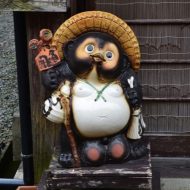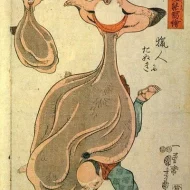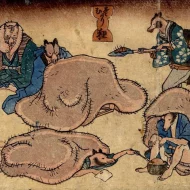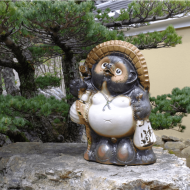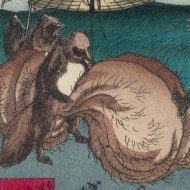Tanuki : The Trickster
Listen
At a glance
| Description | |
|---|---|
| Origin | Japanese Mythology |
| Classification | Animals |
| Family Members | N/A |
| Region | Japan |
| Associated With | Shape Shifting, Mischief |
Tanuki
Introduction
Tanuki are a type of mythological creature in Japanese folklore. They are often depicted as evil doers with bad luck and possessed humans. Later stories show them as a type of harmless prankster. Instead of “monster tanuki,” the better translation would be “trickster tanuki,” as these are typically harmless creatures except for their propensity for deception. A Japanese Raccoon Dog, also known as Tanuki, is a real animal that is known for its mischief and magic. Although it rarely harms humans, it is full of surprises and pranks.
Even though the tanuki is an actual animal, it has always been regarded as a supernatural creature in literature. The earliest known appearance of this animal in a book is in the chapter about Suiko in Nihon Shoki. In the chapter, the creatures turn into humans in a country called Mutsu, and they sing songs. These types of animals eventually appear in various other works such as the Uji Monogatari and Nihon Ryiki. In certain regions of Japan, there are bake-danuki that are known to have abilities similar those of foxes. They can appear as humans or other creatures.
Physical Traits
Although they are small, the raccoons look like dogs. Their fur is long and puffy, which makes them look plump. Also, a mask of black fur around their eyes makes them look like a bandit or trickster. Their short tail and dog-like paw pads make them look like they have canine-like features.
With magical powers, the tanukis have eight distinct characteristics. Apart from their hat, which protects them from bad weather and misfortune, they also possess virtue and trust. They drink sake, which is a type of alcohol made from rice, and they hold a note that symbolizes trust.
These creatures have large eyes and are capable of making decisions. They also have large fluffy tails that symbolize wealth, a large stomach, and a playful and friendly demeanor.
Family
The inspiration for the Tanuki’s magical attributes came from China, where folk believed that wildcats, such as leopards, were god-like creatures. Since Japan didn’t have any of these animals, Japanese scholars were able to grant other creatures such as weasels, cats, and wild boars the power to perform magic. The Fox and the dog became the most popular types of tanuki, and they are regarded as gods.
When Buddhism became prevalent in Japan, the idea of deifying animals became less prevalent. Only creatures associated with the gods were regarded as powerful. The raccoon dog, on the other hand, became a trickster instead of a god.
Other names
There are various types of Tanuki based on the region that they are being worshipped or being spoken about. They are Danzaburou-danuki, Shibaemon-tanuki, Yashima no Hage-tanuki, Bunbuku Chagama, Sōko-tanuki, Tanuki-bayashi, Fukurosage, Owarezaka, Jūbakobaba, Fūri, Akadenchū, Kasasashi-tanuki, Kubitsuri-tanuki, Kozō-tanuki, Bōzu-tanuki, Shirodokkuri, Usagi-tanuki and Uchiwata-danuki.
Powers and Abilities
Tanukis are shape shifters, and their testicles play a significant role in their shifting. Legend has it that these animals use their testicles as weapons, drums, and makeshift raincoats. They also massage and knead these testicles into a shape that they desire, and they often act like humans to acquire alcohol and other food.
Various legends about the Tanuki have been presented, and their magical power and personality are well-known. Although they’re known for their mischief, they’re also gentle and kind to people. Tanukis are fascinated by turning into humans and adopting bad habits and lifestyles.
They often pose as individuals who enjoy gambling, drinking, stealing, and lying, and they’ve even impersonated Buddhist monks. Due to their quick adaptability and transformation techniques, these creatures can live for many years in a human-like state.
Tanuki statues are displayed in a shop, and each one has tags that indicate its size and pose. They also have various expressions and pose. Tanukis are known to make fun of people. For instance, they often pretend to talk to a farmer in the dark or make fishermen believe that their nets are full of fish.
In addition to being known for their mischief, the tanukis are also known to go to houses and perform various tricks on their owner. According to legend, they can be distinguished from other tanukis by the type of kimono an individual wears. TanuTanukis tend to become unstable when they’re distracted.
Modern Day Influence
Although the Tanukis can be found in Japanese ink and pen drawings, the most popular medium for capturing these creatures is statuary. Small and jolly-looking, the Tanuki is a common sight in Japanese gardens, just like the gnomes in Western gardens. In today’s video games, the Tanuki has made appearances in Super Mario and Animal Crossing.
Due to their playful nature and ability to attract wealth, tanuki statues are commonly seen in various establishments, such as bars and restaurants. Since these creatures are very cute in real life, people often buy and cuddle stuffed tanukis.
Related Images
Frequently Asked Questions
What is the Japanese myth about tanuki?
Japanese myths portray tanuki as shape-shifting pranksters, using belly drum magic and stretchy golden scrotums to trick humans for amusement, occasionally with moral lessons. These jovial tricksters, despite their outlandish abilities, symbolize prosperity and bring laughter while reminding us that a touch of mischief can add spice to life.
Why are tanuki balls so big?
The exaggerated size of tanuki balls in Japanese folklore adds comical punch to their mischievous nature, fuels stories of their shape-shifting magic, and possibly traces back to real-life uses of their pelts, making them an iconic and humorous part of these trickster creatures’ myth.
What powers do tanuki have?
From shapeshifting and belly drum illusions to magic scrotums and enhanced senses, tanuki pack a playful punch with their powers, weaving illusions, pulling pranks, and occasionally bringing good fortune, proving themselves masters of mischief and magic in Japanese folklore.
Why are tanuki good luck?
Playful pranks, shapeshifting adaptability, abundant bellies, and wealth-manifesting kintama all contribute to the tanuki’s association with good luck in Japan, making them mischievous guardians of fortune and adaptability in Japanese culture.
Are tanuki good or bad?
Tanuki, the whimsical tricksters of Japanese folklore, dance between good and bad, weaving amusement, moral lessons, and even fortune through their mischief, defying easy categorization and reminding us that laughter, lessons, and a sprinkle of playful chaos make life a delightful dance.

